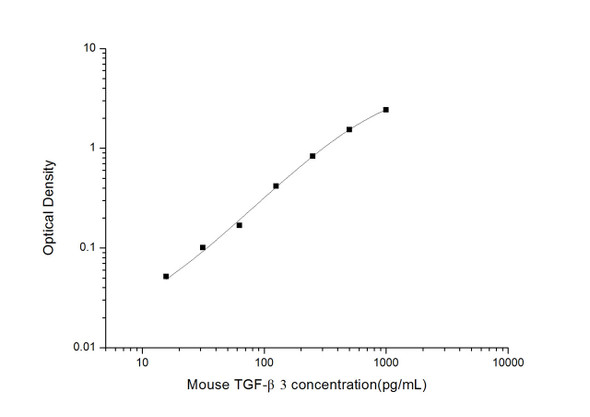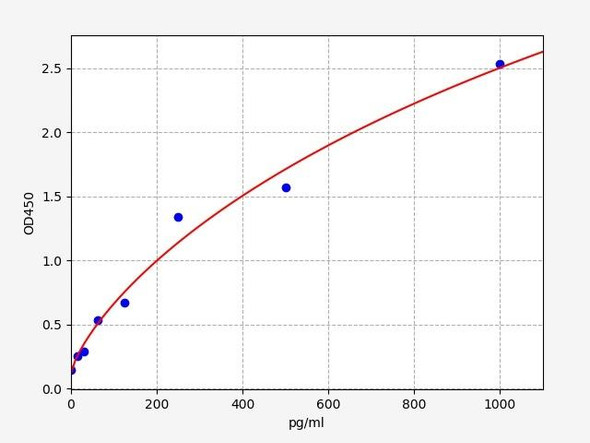Human Cell Biology ELISA Kits 1
Human TGF- beta3 (Transforming Growth Factor beta3) ELISA Kit (HUES03214)
- SKU:
- HUES03214
- Product Type:
- ELISA Kit
- Size:
- 96 Assays
- Uniprot:
- P10600
- Sensitivity:
- 9.38pg/mL
- Range:
- 15.63-1000pg/mL
- ELISA Type:
- Sandwich
- Reactivity:
- Human
- Sample Type:
- Serum, plasma and other biological fluids
- Research Area:
- Cell Biology
Description
| Assay type: | Sandwich |
| Format: | 96T |
| Assay time: | 4.5h |
| Reactivity: | Human |
| Detection Method: | Colormetric |
| Detection Range: | 15.63-1000 pg/mL |
| Sensitivity: | 9.38 pg/mL |
| Sample Volume Required Per Well: | 100µL |
| Sample Type: | Serum, plasma and other biological fluids |
| Specificity: | This kit recognizes Human TGF- beta3 in samples. No significant cross-reactivity or interference between Human TGF- beta3 and analogues was observed. |
This ELISA kit uses Sandwich-ELISA as the method. The micro ELISA plate provided in this kit has been pre-coated with an antibody specific to Human TGF- beta3. Standards or samples are added to the micro ELISA plate wells and combined with the specific antibody. Then a biotinylated detection antibody specific for Human TGF- beta3 and Avidin-Horseradish Peroxidase (HRP) conjugate are added to each micro plate well successively and incubated. Free components are washed away. The substrate solution is added to each well. Only those wells that contain Human TGF- beta3, biotinylated detection antibody and Avidin-HRP conjugate will appear blue in color. The enzyme-substrate reaction is terminated by the addition of stop solution and the color turns yellow. The optical density (OD) is measured spectrophotometrically at a wavelength of 450 nm ± 2 nm. The OD value is proportional to the concentration of Human TGF- beta3. You can calculate the concentration of Human TGF- beta3 in the samples by comparing the OD of the samples to the standard curve.
| UniProt Protein Function: | TGFB3: Involved in embryogenesis and cell differentiation. Homodimer; disulfide-linked. Interacts with ASPN. Belongs to the TGF-beta family. |
| UniProt Protein Details: | Protein type:Ligand, receptor tyrosine kinase; Motility/polarity/chemotaxis; Secreted; Cell development/differentiation; Secreted, signal peptide Chromosomal Location of Human Ortholog: 14q24 Cellular Component: extracellular matrix; extracellular region; extracellular space; plasma membrane Molecular Function:cytokine activity; identical protein binding; protein binding; punt binding; transforming growth factor beta binding Biological Process: alveolus development; in utero embryonic development; intercellular junction assembly and maintenance; mammary gland development; negative regulation of cell proliferation; negative regulation of DNA replication; negative regulation of neuron apoptosis; palate development; platelet degranulation; positive regulation of apoptosis; positive regulation of bone mineralization; positive regulation of collagen biosynthetic process; positive regulation of DNA replication; positive regulation of filopodium formation; positive regulation of protein secretion; positive regulation of transcription from RNA polymerase II promoter; positive regulation of transcription, DNA-dependent; regulation of apoptosis; regulation of cell proliferation; regulation of MAPKKK cascade; response to hypoxia; response to progesterone stimulus; salivary gland morphogenesis; transforming growth factor beta receptor signaling pathway; uterine wall breakdown Disease: Arrhythmogenic Right Ventricular Dysplasia, Familial, 1; Rienhoff Syndrome |
| NCBI Summary: | This gene encodes a member of the TGF-beta family of proteins. The encoded protein is secreted and is involved in embryogenesis and cell differentiation. Defects in this gene are a cause of familial arrhythmogenic right ventricular dysplasia 1. [provided by RefSeq, Mar 2009] |
| UniProt Code: | P10600 |
| NCBI GenInfo Identifier: | 135684 |
| NCBI Gene ID: | 7043 |
| NCBI Accession: | P10600. 1 |
| UniProt Secondary Accession: | P10600,Q8WV88, |
| UniProt Related Accession: | P10600 |
| Molecular Weight: | 35,708 Da |
| NCBI Full Name: | Transforming growth factor beta-3 |
| NCBI Synonym Full Names: | transforming growth factor beta 3 |
| NCBI Official Symbol: | TGFB3 |
| NCBI Official Synonym Symbols: | ARVD; LDS5; RNHF; ARVD1; TGF-beta3 |
| NCBI Protein Information: | transforming growth factor beta-3 |
| UniProt Protein Name: | Transforming growth factor beta-3 |
| Protein Family: | Transforming growth factor |
| UniProt Gene Name: | TGFB3 |
| UniProt Entry Name: | TGFB3_HUMAN |
As the OD values of the standard curve may vary according to the conditions of the actual assay performance (e. g. operator, pipetting technique, washing technique or temperature effects), the operator should establish a standard curve for each test. Typical standard curve and data is provided below for reference only.
| Concentration (pg/mL) | O.D | Average | Corrected |
| 1000 | 2.497 2.507 | 2.502 | 2.431 |
| 500 | 1.557 1.597 | 1.577 | 1.506 |
| 250 | 0.94 0.92 | 0.93 | 0.859 |
| 125 | 0.487 0.499 | 0.493 | 0.422 |
| 62.5 | 0.268 0.256 | 0.262 | 0.191 |
| 31.25 | 0.18 0.164 | 0.172 | 0.101 |
| 15.63 | 0.122 0.124 | 0.123 | 0.052 |
| 0 | 0.067 0.075 | 0.071 | -- |
Precision
Intra-assay Precision (Precision within an assay): 3 samples with low, mid range and high level Human TGF- beta3 were tested 20 times on one plate, respectively.
Inter-assay Precision (Precision between assays): 3 samples with low, mid range and high level Human TGF- beta3 were tested on 3 different plates, 20 replicates in each plate.
| Intra-assay Precision | Inter-assay Precision | |||||
| Sample | 1 | 2 | 3 | 1 | 2 | 3 |
| n | 20 | 20 | 20 | 20 | 20 | 20 |
| Mean (pg/mL) | 50.82 | 122.56 | 417.08 | 55.11 | 127.89 | 423.60 |
| Standard deviation | 2.93 | 6.75 | 14.43 | 3.84 | 6.56 | 13.17 |
| C V (%) | 5.77 | 5.51 | 3.46 | 6.97 | 5.13 | 3.11 |
Recovery
The recovery of Human TGF- beta3 spiked at three different levels in samples throughout the range of the assay was evaluated in various matrices.
| Sample Type | Range (%) | Average Recovery (%) |
| Serum (n=5) | 86-99 | 92 |
| EDTA plasma (n=5) | 92-102 | 97 |
| Cell culture media (n=5) | 95-107 | 100 |
Linearity
Samples were spiked with high concentrations of Human TGF- beta3 and diluted with Reference Standard & Sample Diluent to produce samples with values within the range of the assay.
| Serum (n=5) | EDTA plasma (n=5) | Cell culture media (n=5) | ||
| 1:2 | Range (%) | 86-98 | 100-112 | 98-112 |
| Average (%) | 93 | 105 | 103 | |
| 1:4 | Range (%) | 88-103 | 83-96 | 86-101 |
| Average (%) | 94 | 88 | 92 | |
| 1:8 | Range (%) | 89-101 | 85-97 | 83-94 |
| Average (%) | 96 | 92 | 88 | |
| 1:16 | Range (%) | 93-108 | 86-99 | 88-98 |
| Average (%) | 100 | 91 | 93 |
An unopened kit can be stored at 4°C for 1 month. If the kit is not used within 1 month, store the items separately according to the following conditions once the kit is received.
| Item | Specifications | Storage |
| Micro ELISA Plate(Dismountable) | 8 wells ×12 strips | -20°C, 6 months |
| Reference Standard | 2 vials | |
| Concentrated Biotinylated Detection Ab (100×) | 1 vial, 120 µL | |
| Concentrated HRP Conjugate (100×) | 1 vial, 120 µL | -20°C(shading light), 6 months |
| Reference Standard & Sample Diluent | 1 vial, 20 mL | 4°C, 6 months |
| Biotinylated Detection Ab Diluent | 1 vial, 14 mL | |
| HRP Conjugate Diluent | 1 vial, 14 mL | |
| Concentrated Wash Buffer (25×) | 1 vial, 30 mL | |
| Substrate Reagent | 1 vial, 10 mL | 4°C(shading light) |
| Stop Solution | 1 vial, 10 mL | 4°C |
| Plate Sealer | 5 pieces | |
| Product Description | 1 copy | |
| Certificate of Analysis | 1 copy |
- Set standard, test sample and control (zero) wells on the pre-coated plate and record theirpositions. It is recommended to measure each standard and sample in duplicate. Note: addall solutions to the bottom of the plate wells while avoiding contact with the well walls. Ensuresolutions do not foam when adding to the wells.
- Aliquot 100µl of standard solutions into the standard wells.
- Add 100µl of Sample / Standard dilution buffer into the control (zero) well.
- Add 100µl of properly diluted sample (serum, plasma, tissue homogenates and otherbiological fluids) into test sample wells.
- Cover the plate with the sealer provided in the kit and incubate for 90 min at 37°C.
- Aspirate the liquid from each well, do not wash. Immediately add 100µL of BiotinylatedDetection Ab working solution to each well. Cover the plate with a plate seal and gently mix. Incubate for 1 hour at 37°C.
- Aspirate or decant the solution from the plate and add 350µL of wash buffer to each welland incubate for 1-2 minutes at room temperature. Aspirate the solution from each well andclap the plate on absorbent filter paper to dry. Repeat this process 3 times. Note: a microplatewasher can be used in this step and other wash steps.
- Add 100µL of HRP Conjugate working solution to each well. Cover with a plate seal andincubate for 30 min at 37°C.
- Aspirate or decant the solution from each well. Repeat the wash process for five times asconducted in step 7.
- Add 90µL of Substrate Reagent to each well. Cover with a new plate seal and incubate forapproximately 15 min at 37°C. Protect the plate from light. Note: the reaction time can beshortened or extended according to the actual color change, but not by more than 30min.
- Add 50 µL of Stop Solution to each well. Note: Adding the stop solution should be done inthe same order as the substrate solution.
- Determine the optical density (OD value) of each well immediately with a microplate readerset at 450 nm.






